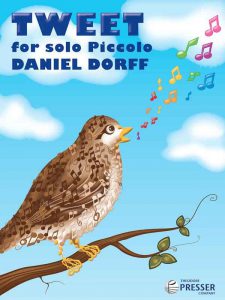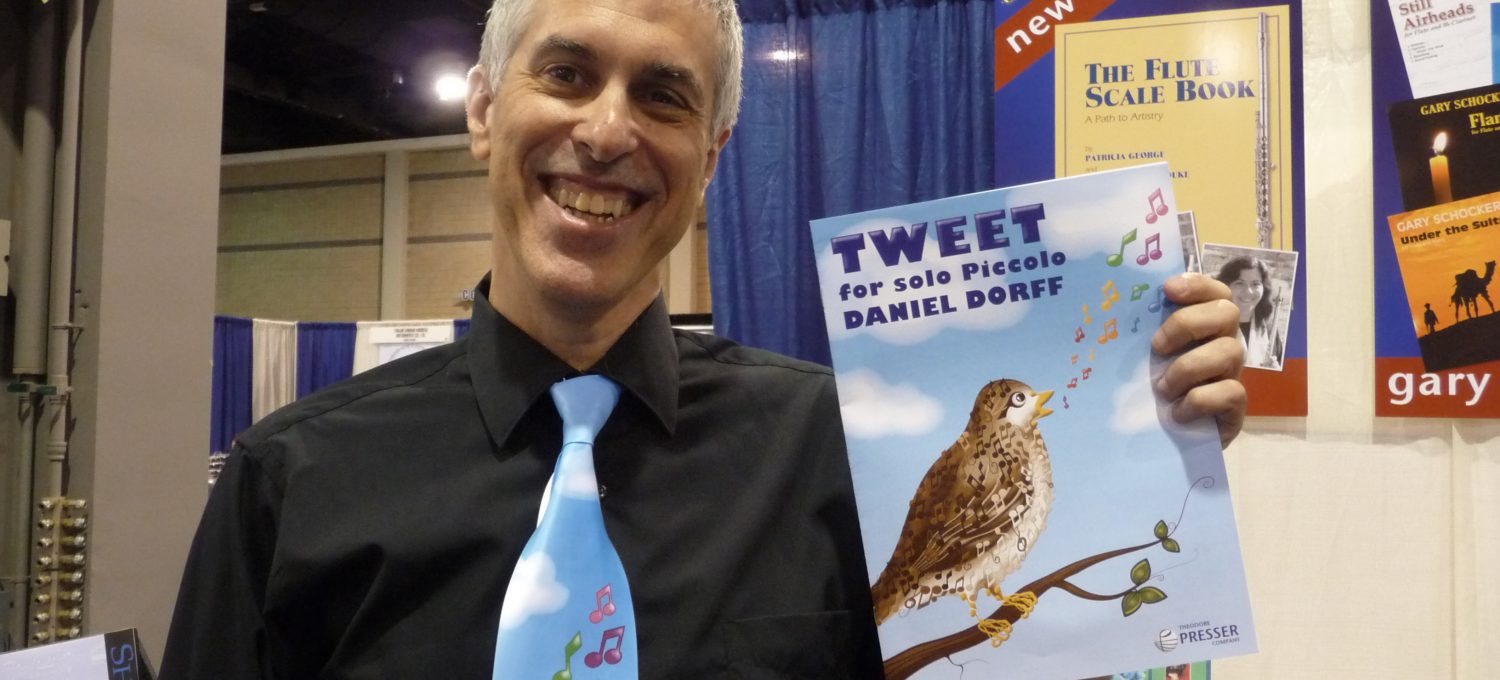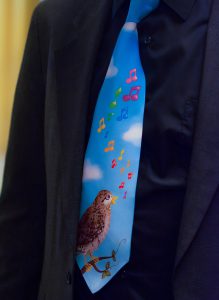ORIGIN OF THE COMMISSION
The piccoloist Lois Herbine lives near me in the suburbs of Philadelphia, but we never met until the 2000 NFA convention. Lois heard Jan Gippo and Martin Amlin premiere Sonatine de Giverny there, and soon after that she chose Giverny to be the opening work on her “Take Wing” CD. Before long, Lois had performed most of my flute music, including several premieres.
In early 2010, Lois commissioned me to write a piccolo piece to premiere at that summer’s International Piccolo Symposium. Flash! had been introduced at the 2008 Symposium and won the composers’ competition, and Lois was eager to follow with another new Dorff piece at the IPS. I agreed and decided to write for unaccompanied piccolo, adding to that type of repertoire and to sound different from my other piccolo music.
ORIGIN OF “TWEET”
In composing for solo piccolo, I set out to create music inherently conceived for the piccolo’s beauty, distinct from flute music sounding 8va. One morning in May, when hundreds of robins in my maple trees woke up with a wall of sound long before I wanted to awaken, I thought about the birds, about the delightful song “Rockin’ Robin,” and about bird-like arpeggios in chains of thirds. Before long, the main theme (bars 1-9) revealed itself, along with a plan to juxtapose opposites.

Ex. 1: Main motive of Tweet
This latter point about juxtaposing opposites is one of the main “secrets” to performing Tweet effectively. Making the most of contrasting dynamics and articulations will keep Tweet sounding fresh for all of its 4½ minutes, and it’s a great way to show off how versatile and three-dimensional the piccolo really is!
STRUCTURE OF THE MUSIC (The Key to Phrasing)
Tweet is a large A-B-A, with some internal symmetry within the overall sections. It could also be described as ABAB- big C section – ABAB.
Following bars 1-9 which are loud, exuberant, and primarily arpeggios, an opposite section answers – sotto voce and primarily scales. Both are grounded around D major, but the first section jumps around chromatically, and the second section is strictly diatonic with ambiguity about which note is actually the tonic. Bars 20-36 are a variant of the opening, and 37-46 are identical to the second section other than a slight difference toward the end. Becoming well-oriented within this structure of bars 1-46 is the key to knowing how to phrase and contrast within this section, and ultimately how to build a concept of the whole piece. The surface may seem rather ornate, but the underlying architecture is relatively simple and traditional.
The middle section (bars 47-108) seems full of new ideas, but it’s all derived from the opening motives featuring chains of thirds alternating with scales, subito dynamics, and a lot of teasing playfulness.
 Ex. 2: beginning of the middle section
Ex. 2: beginning of the middle section
The instruction “secretly tiptoeing” is more meaningful than it might seem at first. It’s not just quiet and staccato – a secretly tiptoeing robin (or flutist) touches the ground as gently as possible for minimum impact. This adds to the breadth of the piccolo’s color palette and paves the way for maximum contrast at the recapitulation.
The recapitulation at 109 is almost the same as the opening section, except for a surprise recoloring in D Minor, and a little coda. Unlike most of my music, Tweet is full of exact repetitions rather than little variants. This makes it easier to learn, and perhaps more neo-classical in feel.
INTERPRETATION & PERFORMANCE SUGGESTIONS
The difference between merely a clean performance and an impressively effective one is largely in the strong contrasts in dynamics and articulation – exaggerate them! Another interpretive variable is how much or where to be rigid or flexible with the tempo. There are many ways to pace this (as with the solos of Bach or Paganini), and it’s another aspect of planning an interpretation. Drawing an analogy to theater, one can correctly state the words “to be or not to be,” or one can hold the stage with a dramatic oration of the same phrase.
I’ve been fortunate and fascinated to hear many wonderful performances with widely varying approaches. Lois Herbine premiered Tweet at the 2011 NFA convention – her performance was notably dramatized, exaggerating the dynamics and interpolating extra accelerandos and cutoffs. It was much more impulsive than I’d anticipated, and the audience (including the composer) loved hearing the theatrical narrative that Lois unfolded. A few months later, Gudrun Hinze surprised me with a Christmas present, her youtube of Tweet played in a German castle! Gudrun, who plays in the Bayreuth Festival’s opera orchestra and the Leipzig Gewandhaus Orchestra, played Tweet for its sheer beauty – very lyrically and “as written.” Gudrun’s remarkable video has about 375,000 views as of this writing and is on countless playlists for orchestration classes. Gudrun Hinze’s Performance of Tweet
There are many ways to pace Tweet successfully – make it your own!
TIPS AND TRICKS FOR THE LEARNING PROCESS
1) Following Keith Hanlon’s 2015 Frostburg recital, Laura Benning mentioned that she’d love to work on Tweet but the grace notes are too fatiguing to read, particularly with the many small accidentals. Keith grinned in agreement like the Cheshire Cat, having just performed two of my other piccolo works but not Tweet. I love helpful advice like this and made a new edition with larger grace notes. The newer Presser edition (with black lettering on the back cover) has larger grace notes than the first printings (blue on the back), and these are easier to play from.
2) A number of piccoloists have told me they first learned Tweet on C flute, and then switched over to piccolo once the technique was under control. While that sounds counterintuitive, they all said an hour workout learning the grace note patterns is physically stressful on piccolo, but not stressful on C flute.
3) Because there’s a phrase-by-phrase form and all the grace note groups are chords, some performers write out the chord names, or the key that each phrase actually plays in. This can make it easier to perform “half-memorized” without needing to read every little accidental.
4) The phrase structure is rather straightforward. Practicing without the grace notes in bars 1-36 reveals a simple pattern with a metric stress on beats 2-3-4-1, 2-3-4-1, as Example 1 (above) illustrates. Practicing bars 1-36 without the graces can give a more direct sense of how to phrase the piece, and then graces can be gradually added back in. They ideally are like the fluttering of wings, lifting the phrases rather than weighing them down.
COVER ART & MATCHING TIE
I knew from the start that the publication’s cover art had to be a robin chirping out animated eighth notes. This is a perfect homage to the robins that inspired the music, the animated chirping of the music, and an image that was born with the music. The wonderfully charming cover was created by my daughter Julia Mieko Dorff, who later sent me a matching tie.



Gudrun Hinze is one of my absolutely favorite Piccolists. Her recording of the Allan Stephenson Piccolo concerto is magnificent. The Tweet is also beautifull. I must try and get hold of it from somewhere? Other favorites are Nicola Mazzanti( I swear by his method book), Danielle Eden ( also excellent method book) and Jean – Louis Beaumadier( excellent pedagogue with many new edited Piccolo pieces).